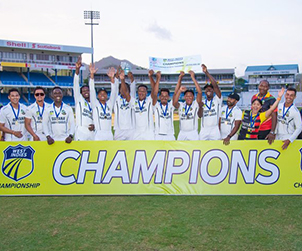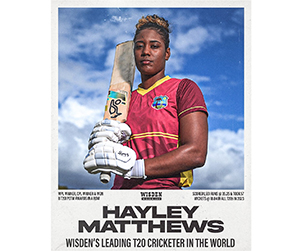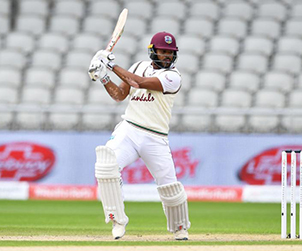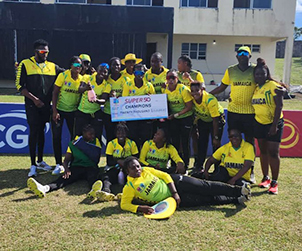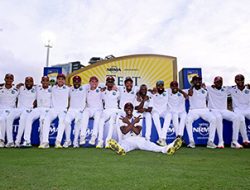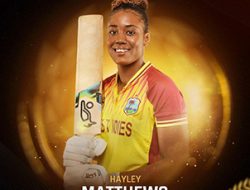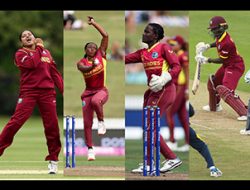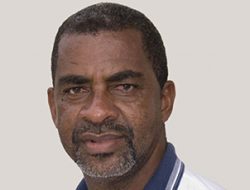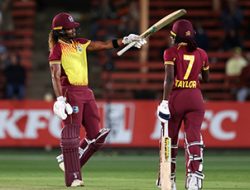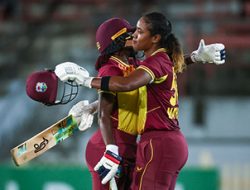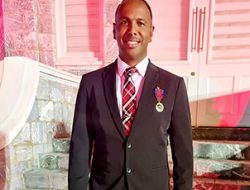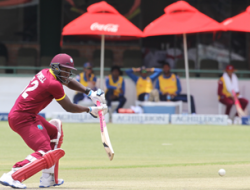Former West Indies batsman Ramnaresh Sarwan talks about chasing 418, learning from Lara, and getting bogged down in the last few years of his career
Where is your signature red bandana?
I still have them at home. A lot of people thought I was wearing the bandana for style, but the real reason was my helmet was too big in my early years in cricket. I could not find the right-sized helmet, and the one I was using was pretty comfortable. So I had to try and find a way to make sure the helmet fitted properly. That is how I started using the red bandana. All of a sudden it became a trademark and people started sending me bandanas as a gift.
How many did you collect?
Over a hundred – in red and white as well. Fans would write messages on them.
You played some of your finest cricket in Antigua and Barbados. Which of these two venues is your favourite?
Apart from those two venues, my other favourite was Cape Town. It has a really good environment and is a picturesque venue. But, yes, I like Barbados a lot because that was where I made my Test debut, against Pakistan, which had a special bowling attack – Wasim [Akram], Waqar [Younis], Saqlain [Mushtaq]. To perform against those guys was seeing my dream becoming a reality.
You also made your highest Test score in Barbados – 291 against England. That must have been special too?
During that series I felt I was at my best. Before coming to Barbados, I had scored a century in Jamaica, followed by 94 and 106 at St John’s. On the flight to Barbados, there was some constructive criticism from a couple of friends, who said I was getting a bit too loose when I got to hundred. They said I should concentrate harder. So I made a promise to them that the next time I got to hundred, I would make a double.
I was determined to get a double-hundred [in Barbados]. At the end of day three, I was unbeaten on 184. While heading back to my room that evening, I entered the elevator and one of my friends from the plane entered at the same time and said: “So you have taken my advice.” (laughs).
That whole series, I felt I was trying to be more mature and understanding my game much more. That was going to be the turning point where I was going to become much more consistent in my career.
What changed for you in that series where you were on top of your game?
Prior to that series I did not really have much of a hiccup. In that England series I was in the best frame of mind in my life. Personally, I had a chance for myself, something I probably never had early in my career. The constant difficulty of strikes at the time [West Indies’ players went on strike due to contractual disputes with the board] took a mental toll on me. In the New Zealand series, prior to England, I did not really do that well. But against England, I was starting to focus. Not that I was not focused before, but I kind of figured out my game much more.
Can you think back to May 2003 and your fourth-innings chase of 418 against Australia in Antigua?
We were up against history. I don’t think anyone gave us a chance, not only the way we had been playing till then in that series but also throughout that year – we had been very inconsistent. But the thing that stood out in that particular game was, the surface remained really good throughout the Test match. At no point did we really doubt ourselves. And, of course, when you have Brian [Lara] in your team, you know there’s a chance. That is the mindset he had taught us: once you give yourself a chance, there is nothing that is impossible. That is how we set our innings. We did not really play for a draw. They attacked quite a bit. They were looking for wickets and gave us the scoring opportunities. The fact that we were scoring so quickly and not losing wickets on a regular basis put us in good stead for the chase.
You made 105, against a bowling attack of Glenn McGrath, Jason Gillespie, Brett Lee, Stuart MacGill.
I got a lot of confidence from that innings. They were the best team in the world. Throughout that series I was getting starts, but never really converted any into a big score. So to play such an important innings and to win the game was pleasing. I enjoyed playing a lot of cut shots against MacGill because of the length and line he was bowling – short and wide, which allowed me to put them away. I also played a few good on-drives off the second new ball. Then the shot off Lee to move from 94 to 98 – it was probably one of the hardest pull shots I ever played.
Was that your best innings?
It is, without a doubt, taking everything into consideration – the amount of sledging, the verbal abuse that went back and forth. The match was evenly poised till the last day, and it was a very hard contest.
How much did the sledging spur you on?
I have never had people sledging me, because I am not afraid to give it back. Very early in my career I was very disruptive and very vocal. But I think there comes a point where you don’t cross the line, when you are attacking the person personally. The thing that really affected me in Antigua was the answer I gave back [to McGrath]. I didn’t know at the time what the situation with Glenn’s wife [Jane, who was suffering from breast cancer] was, and that took everything overboard.
McGrath admitted that the altercation did affect him too. Did the two of you make up that evening?
We did. As soon as the game finished, I went across to him. I hugged him and told him I’m sorry because I wasn’t aware of the situation. He apologised as well. Both of us did not have any hard feelings. What happens on the cricket field should be left there.
Has sledging become too personal? We have witnessed ugly altercations in the last few years between Australian and West Indies players – like Marlon Samuels v Shane Warne and Kieron Pollard v Mitchell Starc.
Once it gets personal, people will start to overstep the boundaries. That is something that needs to be put under control. Of course, people tend to take certain things personally, but throwing bats at people is not acceptable.
This is what David Hookes, the former Australian batsman, had to say about you. Your strengths, he said, were: wide range of strokes, nimble footwork, watches the ball, technically excellent. Weaknesses: compulsive hooker, no sense of restrain, gets rattled in verbal contests. Do you agree?
I don’t agree with the verbal part. Apart from the incident with Glenn, whenever people sledged me, I found it funny. I agree with the part that I was a compulsive hooker. That is how I have played my entire career. I was very instinctive with my strokeplay.
Other than instincts, can you talk about the things that needed to fall in place for your batting to succeed?
I was very aggressive early in my innings. I could have probably been a little more patient. Most of the times when I got out early, it was me trying to play an attacking shot. Throughout my career I was trying to work on different stuff. When I started I had quite a bit of problem getting lbw, so I needed to stay much more balanced. Those things worked themselves out as my career went along. But by the time I really started to mature and understand my game and get to a point where I started feeling really comfortable, things started to go downhill for me.
You announced your retirement under the tree where, as a 12-year-old, you started playing cricket. Whose idea was it?
It was mine. It was at the school where I started playing – Stella Maris Primary School. It is always important to remember where you come from, especially where you got your first opportunity. I started in 1991, and that particular place will always hold special place in my heart. If I had not attended that practice session, I don’t think I would have played for West Indies. So I went back there to call it a day. It brought back a lot of memories I am very proud of.
This February you said you still had cricket left in you ahead of the CPL. Six months later you decided to call it quits. What made you change your mind?
My main objective was to try and play in front of the crowd in Guyana. That was in my heart. No one knew that. Dwayne [Bravo] came to Guyana a couple of months before the CPL. He asked me if I would be interested in playing for Trinidad [Trinbago Knight Riders]. I told him I would be very grateful if I got the opportunity. There was one match we played in Guyana, where I did not bat, but while I was fielding, my back started to act up again. We did rehab throughout the tournament and the medical staff tried their best to get me sorted to play again. But it was proving difficult. At that time I decided. I basically had my wish: I was able to play in front of my fellow Guyanese people. So my heart was at ease. It was very difficult for my body to continue, so that was the reason I decided to announce my retirement.
At 31 a batsman usually is at the peak of his powers or close to it. But in your case, you played your last Test at that age. Did you imagine then that you would never return in whites?
It is interesting you mention this to me, because probably only a month and a half ago I recognised that my career finished at 31 and that I wasn’t going to play Test cricket again. Like I said earlier, I felt, at 29, I was at my best. That was against England at home. I was at my best then. But I never really would have imagined my career would finish at 31. I wanted to play till I was 35, at least. And that would be based on my performance and not favour. But mentally I was burnt out, not from playing but from what was happening with the West Indies Cricket Board and within our team.
In 2012, a year out of the West Indies dressing room, playing well for Leicestershire in your first season, you recounted the mental stress you suffered: “Mentally I was broken down, not from the stress of playing, it’s just certain individuals have drained me mentally. It took a toll on my confidence and the way I play. Everything went away.” You said you would not come out of the house for three days if your dad hadn’t pushed you. What exactly happened then?
The period I’m talking about is around 2011-12, around the World Cup. You have a coach or coaches saying that they want an individual to fail and just wishing that the individual fails so they could drop him. It was very clear what their objective was. When you are so accustomed to playing with a free mind and that kind of internal fighting goes on, you recognise that they are trying to drop you for the wrong reasons. Mentally it affected me badly. I could not come out of the house. My passion, my love, my confidence, everything that I worked my entire career to build, everything just went away in a space of a few months.
The mental duress was evident in my batting. Rather than focus on the ball, I was thinking about the stuff going through my head. I was playing as if this would be my last match. That was the feeling I played with in my last two Test matches.
How did you draw the conclusion that you were being sidelined? Was it based on your interactions with the coaching staff?
It was actually the coaches. You can’t be a coach of the team telling fellow team-mates of mine that you want me to fail so you can drop me. There was a lot of negative stuff. Actually, it is very difficult to recount it, so I try not to think about too much.
Did you try to have a one-on-one chat with Ottis Gibson, West Indies’ head coach at the time?
It was very clear what they were trying to do. It is clear that they were trying to give the Test captaincy to Darren Sammy.
In 2010, the WICB dropped you from the contract list, saying you had an “extremely indifferent attitude and sporadic approach towards fitness”. In hindsight, was the board’s assessment correct, even partially?
No, it was not. That was proven when I won the arbitration case. I felt very strongly about it. I was certain they would take the contract away from me. I knew it was coming. It was clear that they wanted to remove a few players to allow Sammy to become the captain.
Is that when you felt yourself begin to lose the drive inside you?
Yes, it did. In 2009 I scored the most runs in the series against England. A few months down the line, my attitude was bad all of a sudden?
You finished with a Test average of 40.01. Would you agree that you were an underachiever?
Yes, I should have scored a lot more runs and finished with a better average, of course. But I could have played for another four to five years. As I said, in 2009, I was understanding my game better. Then my contract was dropped. Then I get dropped in 2011. Put that into the context. I don’t know if I would have scored one more or ten more centuries. At the time, instead of sitting out, it would have been much better [to be] playing. It is hard for me to say where I could have finished.
You led West Indies only four times in Tests and a few times in ODIs. But injuries forced you out, and when you came back, Chris Gayle was in charge. Did that hurt you or distract you from your batting?
No, I don’t think it was going to hurt or distract me. Whether I was captain or vice-captain, I was playing with the same intensity and heart. That was always my mentality. I have never felt being a captain would make me a better player or not being a captain would make me less of a player.
Why did you step down as vice-captain to Gayle during the New Zealand tour?
I prefer not to disclose the reason. It is personal.
Lara and Shivnarine Chanderpaul are the last two greats of West Indies cricket in the modern era. What did you learn from them?
I had the privilege to play with both those greats. Shiv is more conservative and more patient. Being from the same country – Guyana – helped. He also taught me to try and occupy the crease as much as I could. Brian was different. He was flamboyant and took the attack to the bowlers. I tried to listen to him much more because of the way he played. I fashioned my batting and my approach based on what he advised me over the years. And that is why I was able to win quite a few games for West Indies when we were in situations from where you would probably have thought we couldn’t win games.
You once said this about Lara: “Lara was in a different class by himself. He taught me how to win matches. He also guided me in terms of which bowler I should and shouldn’t take on.” Can you give us an example?
During the Australia Test match in 2003 in Antigua, he just said: don’t think about the score.
One particular instance I remember batting with him where he taught me how to pace the innings. It was the final innings of the final Test of the home series against Sri Lanka [in 2003]. Our target was 212. Brian helped me to play Murali [Muttiah Muralitharan] better in that innings. He told to get after Murali if he was bowling in one particular area. He taught me to analyse bowlers and take the weakest one on – and this is without disrespecting anyone. Those inputs from Brian were always helpful.
You were more consistent in ODIs, where you have some fine numbers. Did you ever work out why?
I think it was because of the different roles. In ODIs, regardless of the situation we were in, especially during a chase, I thought I could single-handedly win a game. I never felt we were out of the game.
Do you know in one-day cricket your average is better than Lara’s and only lesser than Gordon Greenidge’s and Viv Richards’?
Really? You see, so much more cricket I had left in me!
What was your best ODI innings?
Against India in St Kitts [Sarwan made 115 not out]. We were chasing 246. We lost couple of early wickets, so I had the opportunity to build my innings. It was a well-paced innings and it was one of the most memorable wins, because a lot of people did not give us a chance to beat India.
Who was the best bowler you faced and what was the toughest spell you faced?
The toughest spell I faced came against McGrath in Brisbane during the 2005-06 tour. [In the second innings, Sarwan made 31 in three hours]. I literally could not touch a ball for three overs. The ball was seaming around on the bouncy surface at the Gabba and McGrath was bowling perfect lines and lengths. It was difficult to play him. McGrath was annoyed because I could not edge it (laughs).
Murali was the toughest. I had the privilege to play against him on my very first trip to Sri Lanka [in 2001]. When I first saw him bowl on TV, I was shocked. During the training session, when I saw him approach the bowling crease, I could not believe I would be playing against him. It was an amazing experience. I was able to score 300 runs [318] in the three-Test series, and he got me out four times. They were challenging conditions. It was a good test for me. The way he bowled, it was really difficult to play him. At times Brian would stay on strike and wouldn’t want me to face Murali. He was that difficult.
Let us talk about the current situation of West Indies cricket. Without taking sides, can you put a finger on why exactly West Indies cricket has failed to grow?
Forget for once about the management and the WICB. The fact that we don’t have a proper structure in place is the biggest thing missing in our cricket. We need an academy to help groom players for the highest level. There is no issue or shortage of talent in the Caribbean: young Kraigg Brathwaite, Carlos Brathwaite, Jason Holder, Shane Dowrich – all these guys came from the Under-19 level. I don’t think we have the structure to help these players perform consistently at the highest level.
Even a very talented batsman like young Bravo [Darren Bravo] would perform, but he would not be able to meet his full potential. If you look at Chris [Gayle], myself, Wavell Hinds, we were able to go on West Indies A tours prior to our selection for the international team. A tours are going on now, which is very good. But after that those who are not selected but have the talent to become international players – you need to help them. Create a pool, have a good structured academy with good coaches in the Caribbean who can help the players physically, mentally and technically.
It is not just about going out to bowl and bat. Cricket has become scientific now. I don’t think we have the necessary infrastructure and the building foundation to get the youngsters to move up to the highest level.
What about the WICB high performance centre (HPC), which is in place already?
If you were to take that HPC and compare it to the academies in England, Australia, South Africa, India, it would be like a backyard way of playing cricket. Another issue is, West Indies are a set of different islands. Just having one HPC will not do. Each of the six islands that supplies players to the main West Indies team needs to have its own academy. That is the only way you can help develop talent. Then you can rotate players from these academies so they get acclimatised to different conditions. This way, if not everyone, at least 70% of the players are equipped with skills and the mindset to graduate to the highest level.
Do you approve of the structure put in place in domestic first-class cricket by the West Indies director of cricket, Richard Pybus?
It is very innovative and seems to be modelled on leagues like the IPL. Nothing is wrong with trying it and doing it, because the game is moving forward, so you also do the same with different ideas. But I am not sure if that would work in four-day cricket in the Caribbean. People take a lot of pride when they play for their country. Even with the draft system put in place for four-day cricket, if I’m not wrong, Leeward Islands were taking their own players despite having the opportunity to draft two players from other regions. But I’m open-minded.
What about the coaches? There have been so many that have come and gone.
One of the biggest challenges we as players have faced is the fact that once the board does not get things its way, it penalises players. And it is the same attitude they use against coaches. I recollect former Australian player John Dyson, who had been signed for three years as West Indies coach. WICB wanted Dyson to pick a team the board wanted. He refused to do that. They got rid of Dyson with a year or year and a half to go in his contract. Recently we had Phil Simmons, who was outspoken but had done good stuff. That is one of the biggest downfalls of our cricket. Administrators try to get involved in the actual cricket rather than marketing the product.
Is there anything that would have made your career more fulfilling? Also, is there any change you might have made to your game if given a second chance?
I would have preferred to play for another four or five years. My goal was always to play till 35. And if there is one change I’d make in my game, I would take away that hook shot. The one stroke I would miss playing, though, would be the square cut.
What does Sarwan leave cricket with?
I hope everyone had as much fun as I did because throughout my entire career I always played with a smile on my face. I hope people had a wonderful ride watching me play.

